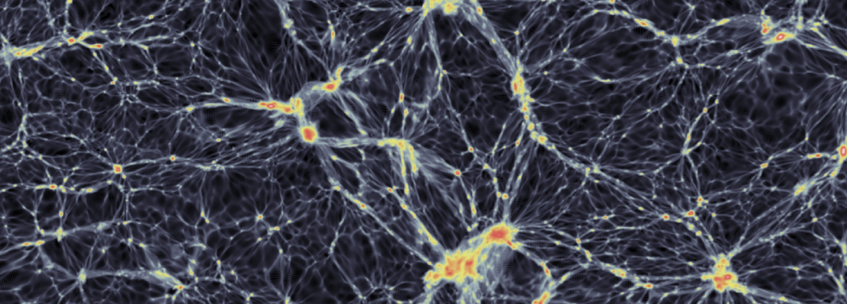Re-Building our Universe from Scratch in a Computer
The structure of our Universe and its history is the largest ‘physics experiment’ that we have. It reflects both what our Universe is made of and the laws that govern its evolution, such as gravity and the other fundamental interactions. Due to the finite speed of light, telescopes can observe the past of our Universe by observing ever more distant objects. This allows us to reconstruct the history of our Universe.
To connect astronomical observations with fundamental physics, our team is modelling the Universe from its earliest moments all the way to today using supercomputers, advanced algorithms, and machine learning and predict observations, e.g. for the Euclid satellite. We ultimately want to contribute to the solution of the big mysteries: what is dark matter, what is dark energy, what are the initial conditions of our Universe…
Our team is associated with both the Institute for Astrophysics and the Dept. of Mathematics, and we are interested in both applications to concrete data, as well as more formal aspects of the involved methods.
Cosmological simulations
Our core interest is in simulations that predict the distribution of matter in the Universe and the formation and evolution of galaxies, galaxy clusters, and the intergalactic medium. We work on developing new methods for cosmological simulations that reach from new numerical methods such as more efficient time integrators, all the way to more realistic astrophysical models in large hydrodynamic simulations. and we also run simulations and analyse and interpret their results! Currently, we are particularly interested in developing
- more accurate simulation techniques for dark matter modelling (see e.g. Hahn & Angulo 2016, Stuecker et al. 2020)
- more realistic astrophysical models for galaxy formation and galaxy clusters (see e.g. Ploeckinger et al. 2023, Pellissier et al. 2023)
- more efficient (and accurate) time integration methods (see e.g. List & Hahn 2023)
- N-body methods as highly accurate forward models for large-scale structure cosmology (List et al., in prep.)
See a recent large topical review article by Angulo & Hahn (2022) on the topic of cosmological N-body simulations.

Cosmological perturbations and initial conditions
Our group is famous for its world-leading ‘MUSIC’ software ecosystem that is used to generate the starting data for large cosmological simulations. We also work on the mathematical underpinnings of perturbation theory (i.e. the mathematical description of the motion of matter in the Universe). Finally, we also work on methods to compute the impact of the physics of the Universe on the shape of these density fluctuations. Our main focus in this area is thus on
- highly accurate initial conditions for large-scale cosmological simulations (e.g. Michaux et al. 2021) - you can access the software that implements all this here
- differentiable solutions of the linearised cosmological Einstein-Boltzmann equations (Hahn et al. 2023)
- bridging the gap between the linear and the non-linear Universe using Lagrangian perturbation theory (e.g. Rampf et al. 2021)
- collapse of cosmological perturbations and associated singularities (e.g. Rampf et al. 2023a, Rampf et al. 2023b, Rampf et al. 2021)

Machine learning and data-driven methods
Finally, we are also very much invested in the rapidly evolving machine-learning field. We are interested in questions ranging from extending the resolution of simulations, interpreting data, all the way to inferring initial conditions and cosmological parameters from observed data. Recently we are also particularly interested in the application of differentiable programming to problems in cosmology.
- Simulation-based inference for cosmology (e.g. List et al. 2023)
- Reconstruction of initial conditions based on incomplete observations (e.g. Porqueres et al. 2020)
- Super-resolution techniques applied to cosmological simulations (e.g. Schanz et al. 2023)
- Interpreting the galactic center excess in gamma rays (e.g. Wolf et al. in prep.)

